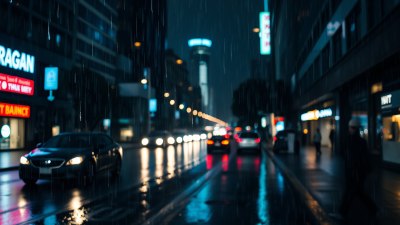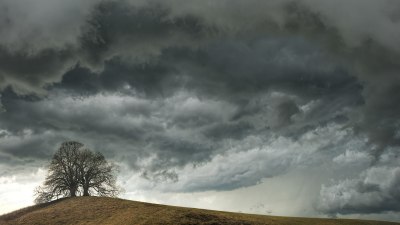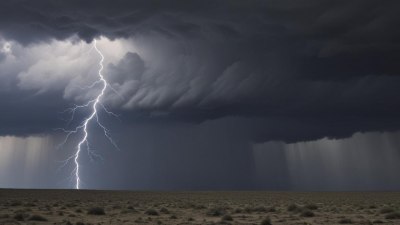Why Some People Feel Like Night Rain on a City Street
Explore why some people resonate with the metaphor of night rain on a city street, reflecting emotions, solitude, and urban life.

The metaphor of feeling like night rain on a city street evokes a deep emotional landscape filled with solitude, melancholy, and subtle beauty. This unique image captures the essence of human experience in moments of introspection, connecting our inner emotional state to the environment around us. Understanding why some people resonate with this particular metaphor involves exploring the symbolic meanings of rain, the ambiance of nighttime urban settings, and the psychological underpinnings of loneliness and reflection.
First, let us unpack the symbolism of rain. Rain has historically represented cleansing, renewal, and emotional release. Its steady patter on surfaces can be soothing or melancholic depending on context. Unlike a sudden storm, night rain tends to be softer, quieter, creating a contemplative mood. In cities, rain blurs the hard edges of pavement and neon lights, turning mundane streetscapes into reflective pools of color and light. This creates an atmosphere ripe for introspection. The sound of droplets hitting pavement or rooftops creates a rhythmic, almost meditative backdrop, inviting those listening to turn inward and process emotions.
For some, feeling like night rain suggests a sense of invisibility or being overlooked. Just as raindrops fall unnoticed amidst the chaotic flow of urban life, individuals might feel like silent observers of their environments, blending into the background without drawing attention. This ties into feelings of anonymity in big cities, where despite being surrounded by millions, people can feel profoundly alone. The rain becomes a metaphor for this invisible presence, quietly affecting the setting but never overtly seen or acknowledged.
Another layer to this metaphor is the emotional complexity conveyed by rain. Rain is neither completely joyful nor purely sorrowful; it is ambiguous and multifaceted. Similarly, people who identify with night rain might be experiencing a mixture of emotions—perhaps sadness tinged with hope or loneliness mixed with peace. This duality makes the metaphor compelling, as it reflects the nuanced states many navigate daily. Night rain is not a dramatic expression but a subtle, ongoing process, mirroring how feelings often unfold gradually within us.
The urban setting adds distinct qualities to this metaphor. Cities at night carry their own paradoxes—teeming with life but often exposing isolation, illuminated yet shadowed. The interplay of artificial lights and darkness creates a cinematic environment where emotions are magnified. Night rain further enhances this by distorting reflections and creating a sense of fluidity in an otherwise rigid, structured environment. It symbolizes the disruption of order and the presence of continual change, reflective of how people experience constant flux in their lives.
Psychologically, identifying with night rain may be linked to introversion or sensitivity. Introverted individuals tend to find solace in quiet, reflective settings, much like a rainy city night. They may feel rejuvenated by solitude and the gentle ambiance rain provides rather than by social interactions. For sensitive people, the rain’s rhythm resonates with their heightened awareness of emotional undercurrents. This sensory and emotional attunement makes the metaphor feel authentic and deeply personal.
Moreover, the metaphor can also embody feelings of resilience and endurance. Rain persists through the night, unyielding and patient, eventually nourishing and refreshing the earth. Those who see themselves as night rain may identify with this persistence through life’s hardships, quietly enduring challenges without spectacle. The rain’s gentle presence is a form of strength rooted in persistence rather than force. It symbolizes the courage to remain present and to flow through difficulties without breaking.
In literature and art, rain frequently serves as a motif for emotional transformation. Characters often undergo significant internal shifts during rainy scenes, suggesting cleansing or catharsis. Night rain, with its quieter tone, suggests subtler transformations—slow realizations, gentle acceptance. People feeling like night rain may be undergoing these types of personal evolutions, where change is internal and gradual rather than overt and dramatic.
Another important aspect is the connection between sensory experience and mood. The sound of rain, the cool dampness in the air, the glistening reflections on wet surfaces—all these sensory details create immersive environments conducive to memory and emotion. For some individuals, these sensory inputs stimulate emotional resonance, amplifying feelings of nostalgia, melancholy, or peace. This sensory-emotional link explains why some find the metaphor of night rain so vivid and meaningful to their inner state.
The cultural context also plays a role. Urban life is often associated with hustle, noise, and fast pace. Night rain introduces a pause, a moment of stillness amidst the chaos. It represents an oasis of calm in a relentless environment. People identifying with night rain might be craving this calmness in their hectic lives or expressing a desire to disconnect and recharge emotionally.
Additionally, the metaphor evokes a sense of temporality and impermanence. Rain does not last forever; it comes and goes, reminding us of the transient nature of emotions and experiences. Feeling like night rain reflects an awareness of life’s fleeting moments and perhaps an acceptance of change as natural. This perspective can be comforting, offering a way to embrace uncertainty and shifts without fear.
Night rain is also associated with poetry and romanticism. The imagery conjures scenes of quiet streets illuminated by streetlamps, reflections dancing on slick pavement, and a soft mist veiling the night. Such imagery appeals to the poetic sensibility, attracting individuals who seek depth and meaning in everyday phenomena. It transcends mere weather to become an emotive landscape where inner and outer worlds meet.
From a neuroscience standpoint, the brain responds to rhythmic, natural sounds like rain by activating areas involved in relaxation and stress reduction. This physiological effect supports why many find night rain comforting or emotionally resonant. The brain’s reaction reinforces the metaphor’s power as a symbol of calm amidst mental or emotional turbulence.
In many ways, night rain acts as a mirror. It reflects the complexity of human emotions—hope and despair, presence and absence, movement and stillness. Those who feel like this rain identify with its layered qualities, finding a metaphor that encapsulates their multifaceted internal landscape. This identification provides emotional validation and a sense of connection to something larger than themselves.
Furthermore, the metaphor extends to notions of invisibility paired with impact. Like night rain nudging the city’s surfaces, individuals might feel that their presence influences their surroundings subtly yet meaningfully. This interplay between quiet influence and unnoticed existence captures the tension many face in social contexts—wanting to be recognized but also valuing humility and subtlety.
Night rain also suggests a bridge between solitude and community. While the rain itself falls individually, it collectively shapes the city environment. In parallel, individuals who feel this way might see themselves as part of a collective human experience, sharing solitude yet connected through shared emotions and reflections. This paradox highlights the simultaneous aloneness and togetherness intrinsic to human life.
It is important to note that metaphors like night rain are personal and subjective. Not everyone will resonate with this image, but for those who do, it offers a language to express feelings that can be difficult to articulate otherwise. Such metaphors enable people to communicate complex emotional states indirectly, fostering empathy and understanding.
Artists, writers, and musicians often use night rain imagery to capture mood and atmosphere. Its evocative power lends itself to creative expression, helping convey subtle emotional tones. This cultural resonance further cements the metaphor’s place in emotional and artistic discourse.
In practical terms, embracing the identity of night rain can encourage mindfulness and emotional awareness. It invites individuals to slow down, tune into their feelings, and acknowledge the beauty in quiet moments. Such an approach promotes mental health by validating the importance of introspection and emotional nuance.
Additionally, the metaphor encourages acceptance of vulnerability. Like rain exposing surfaces to moisture and change, people who see themselves as night rain may embrace vulnerability as a pathway to growth and authenticity. This positive reframing turns perceived emotional fragility into strength.
Night rain also implicitly invokes cycles and continuity. Just as rain cycles between falling, nourishing, and evaporating, human emotions and life events follow rhythms of rise and fall. Recognizing these cycles through metaphor can foster resilience and patience, reminding individuals that difficult moments eventually give way to renewal.
Environmental awareness subtly intertwines with this metaphor. Night rain on city streets emphasizes the interaction between nature and urban life, reflecting on how natural elements persist within artificial landscapes. People who identify with night rain might similarly negotiate their natural emotions amid societal constructs, balancing authenticity with adaptation.
In sum, feeling like night rain on a city street combines sensory experience, emotional complexity, cultural meaning, and psychological insight. It provides a rich, layered metaphor capturing solitude, resilience, invisibility, transformation, and quiet influence. This profound image invites reflection on human experience in all its subtlety, offering a poetic way to understand and express inner worlds amid the vast urban backdrop.
As the night rain gently falls, blurring the edges of the city's sharp geometry, it offers both balm and mirror to those who listen closely. It speaks of presence without demand, of endurance without spectacle, of beauty in the unnoticed. For some, this is not just weather—it is the essence of a feeling, a mood, a state of being that resonates deeply within.
Exploring this metaphor further might involve delving into literature, music, or visual art that captures night rain motifs. Engaging with such works can deepen appreciation of the emotional landscape the metaphor evokes. Whether through a softly jazz-inflected song, a poem evoking rainy nights, or paintings portraying wet cityscapes, these arts give form to feelings that might otherwise remain unspoken.
Ultimately, the metaphor's power lies in its ability to convey the inexpressible, the ambivalent, and the quietly profound. Like the rain itself, the feelings it encapsulates are often overlooked, yet they saturate our lives, shaping our experiences in subtle but meaningful ways. Thus, for those who sometimes feel like night rain on a city street, this metaphor offers not just description but recognition, connection, and solace.











